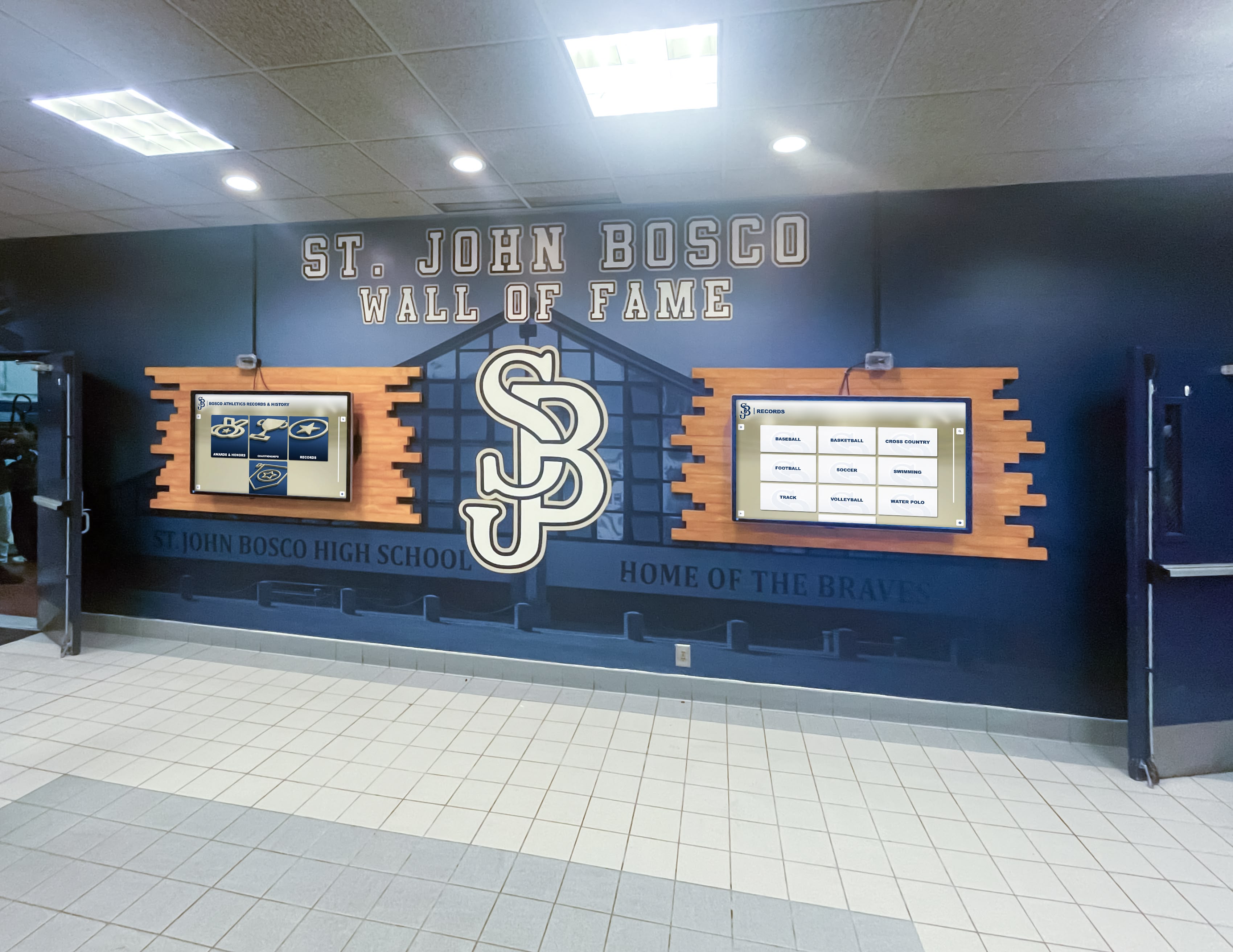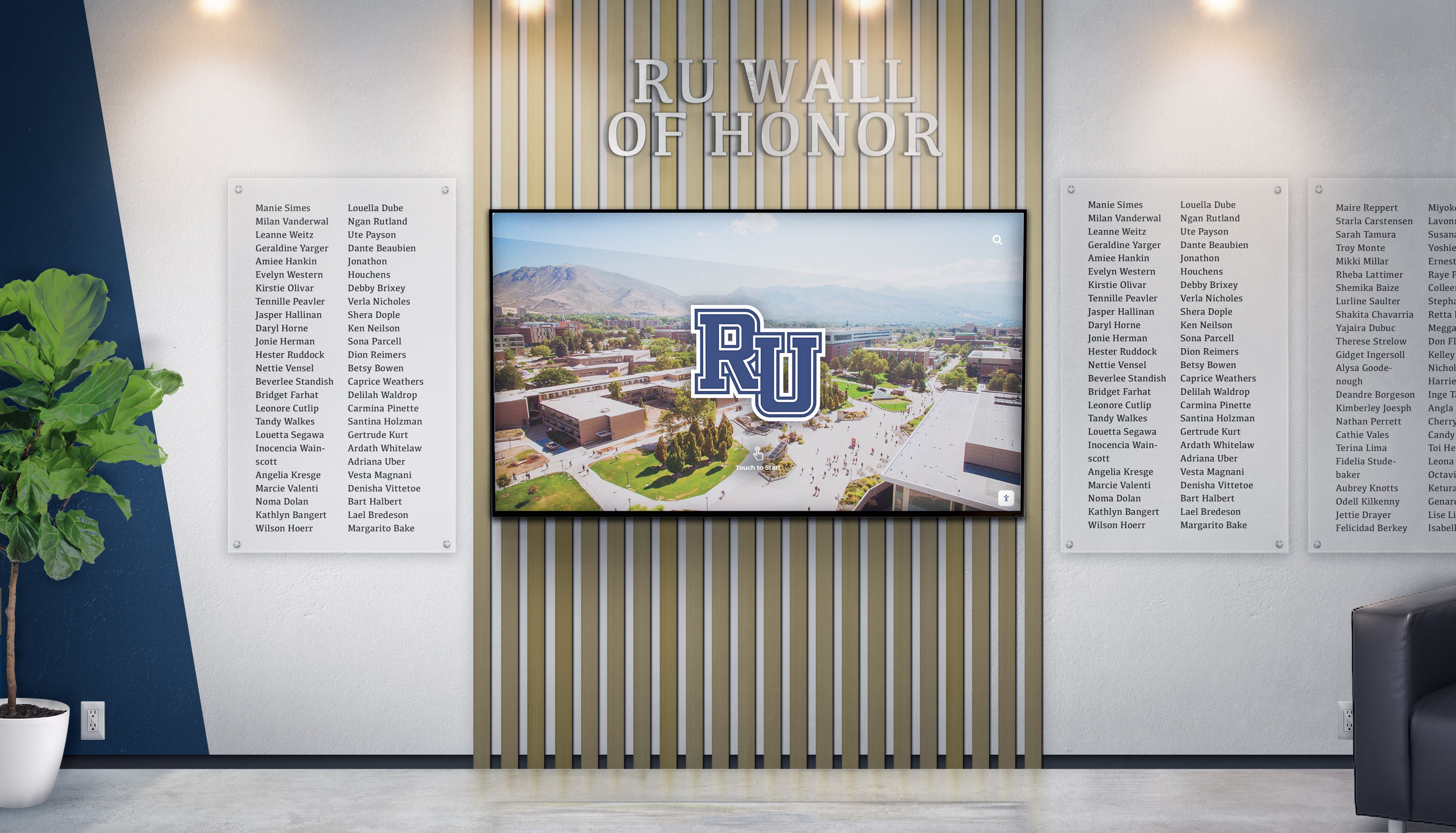Key Takeaways
Complete guide to creating football high school hall of fame programs. Learn about selection criteria, display options, induction ceremonies, and honoring gridiron legends.
Why Football Deserves Special Hall of Fame Recognition
Football holds unique significance in American high school culture, justifying dedicated recognition programs:
- Cultural Impact: Friday night football games serve as community gathering points connecting generations through shared tradition
- Team Excellence: Football's team-oriented nature creates opportunities to honor both individual achievement and collective success
- Comprehensive Achievement: Multiple positions and specialties allow diverse recognition across offense, defense, and special teams
- Historical Legacy: Long football traditions at many schools create rich histories worthy of comprehensive preservation
- Alumni Identity: Football participation often forms core component of alumni identity and school connection
- Motivational Power: Visible recognition of past excellence inspires current players to pursue their own hall of fame aspirations
Schools with established football traditions benefit particularly from dedicated recognition programs that honor sport-specific achievements while complementing broader athletic hall of fame initiatives.

Establishing Football Hall of Fame Selection Criteria
Player Selection Standards
Creating clear, transparent selection criteria ensures fairness and maintains the prestige of hall of fame recognition:
🏆 On-Field Achievement
Statistical excellence in key categories, championship contributions, all-conference and all-state honors, position-specific dominance, and record-breaking performances. Quantifiable achievements provide objective measures of excellence while ensuring recognition extends beyond subjective opinions.
⭐ Character and Leadership
Team captain designation, sportsmanship recognition, academic achievement alongside athletic success, positive influence on teammates, and exemplary conduct representing program values. Character criteria ensure hall of fame honors players who embodied ideals beyond statistics.
🎓 Post-High School Success
College football participation, professional career achievement, career success in any field, community contributions, and continued connection to program. Post-graduation achievement demonstrates lasting impact of high school football experience while inspiring current players.
📊 Time Requirements
Most programs require minimum 10-15 years since graduation before eligibility, allowing sufficient time to evaluate lasting impact and post-high school achievement. This waiting period ensures perspective on career significance while maintaining active player focus on current performance.
Programs implementing comprehensive football record board systems can effectively track career statistics and achievements that inform hall of fame selection decisions.

Coach and Team Recognition Categories
Honoring Coaching Excellence
Comprehensive football halls of fame extend beyond player recognition to honor coaching contributions:
- Head Coach Achievements: Career wins milestones, championship seasons, conference titles, playoff appearances, coach of the year honors, program transformation
- Assistant Coach Recognition: Long-term service, position-specific excellence, player development success, coordinator achievements
- Support Staff Honors: Athletic trainers, equipment managers, team physicians, statisticians who contributed to program success
- Contributor Category: Booster club leaders, facilities donors, community supporters who advanced program development
Coaching recognition acknowledges that sustained program excellence requires leadership and dedication extending far beyond player talent alone.
Team Achievement Recognition
Legendary team seasons deserve special hall of fame recognition:
- Championship Teams: State champions, conference champions, undefeated seasons
- Record-Breaking Seasons: Teams setting offensive or defensive records, scoring achievements
- Historic Victories: Breakthrough wins establishing program credibility
- Dynasty Periods: Sustained excellence over multiple seasons
Team inductions honor collective achievement while recognizing that football success fundamentally depends on unified effort toward shared goals.
Schools honoring coaching excellence benefit from exploring comprehensive coach appreciation approaches that extend beyond hall of fame to celebrate ongoing contributions.
Creating an Effective Selection Process
Nomination and Evaluation Procedures
Transparent processes build trust and ensure worthy candidates receive appropriate consideration:
Nomination Process
- Open Nominations: Accept nominations from alumni, current coaches, community members, and family members during designated periods
- Nomination Forms: Require comprehensive forms documenting achievements, statistics, honors, and supporting evidence
- Nomination Deadline: Establish clear annual deadlines creating predictable rhythm
- Historical Research: Proactively research and nominate deserving candidates from earlier eras who may lack active advocates
- Communication: Publicize nomination process through alumni networks, social media, school communications, and community channels
Selection Committee Structure
- Diverse Membership: Include current athletic director, head football coach, former coaches, distinguished alumni, school administrators
- Rotating Terms: Implement staggered terms ensuring continuity while bringing fresh perspectives
- Evaluation Criteria: Provide committee members detailed scoring rubrics aligned with published selection standards
- Deliberation Process: Conduct thorough reviews of nominations, statistics verification, accomplishment validation
- Selection Limits: Determine annual induction class size (typically 3-8 individuals plus potential team recognition)
- Documentation: Maintain detailed records of deliberations, selections, and rationales for transparency
Well-structured selection processes honor deserving candidates while maintaining program integrity and credibility over time.
Designing Football Hall of Fame Displays
Traditional vs. Digital Recognition Options
Football hall of fame displays range from classic physical installations to cutting-edge digital interactive experiences:
Traditional Display Approaches
- Engraved Plaques: Individual plaques mounted on dedicated hallway or lobby walls listing inductee names, years, and brief achievements
- Trophy Case Integration: Display hall of fame inductees alongside championship trophies and significant program memorabilia
- Photo Galleries: Framed photographs of inductees in action with biographical information and career highlights
- Dedicated Hall Space: Purpose-built rooms or alcoves featuring comprehensive displays of program history and hall of fame members
- Exterior Signage: Prominent outdoor recognition visible to community and visiting opponents
Traditional displays offer timeless elegance and permanent physical presence but face space limitations and update challenges as programs grow over decades.

Digital Interactive Display Advantages
Modern digital hall of fame systems overcome traditional display limitations while creating engaging interactive experiences:
- Unlimited Capacity: Recognize unlimited inductees without physical space constraints limiting recognition
- Rich Multimedia: Include photos, video highlights, career statistics, biographical narratives, and historical context
- Interactive Features: Allow searching by name, year, position, achievement type, or championship team
- Easy Updates: Add new inductees instantly through software rather than physical construction
- Statistical Integration: Link hall of fame profiles to comprehensive program record databases
- Remote Access: Provide online viewing allowing alumni worldwide to engage with program history
- Seasonal Rotation: Feature current season prominently while maintaining complete historical archive
Digital recognition displays from solutions like Rocket Alumni Solutions transform football hall of fame programs by offering comprehensive multimedia storytelling capabilities traditional plaques cannot match while eliminating space constraints that force difficult decisions about who receives recognition.

Planning Memorable Induction Ceremonies
Annual Recognition Events
Induction ceremonies transform hall of fame programs from static displays into living traditions connecting past and present:
Ceremony Timing and Location
- Schedule during homecoming weekend to maximize alumni attendance and community participation
- Coordinate with significant football season moments creating natural celebration opportunities
- Choose venues accommodating inductees, families, current team members, and community supporters
- Consider pre-game, halftime, or dedicated evening event formats based on program preferences
- Plan timing allowing out-of-town inductees to arrange travel and participate fully
Ceremony Elements
- Individual inductee presentations featuring career highlights and achievements
- Video montages showcasing game footage and memorable moments
- Speeches from inductees sharing memories and messages to current players
- Presentation of commemorative items: plaques, rings, jackets, or certificates
- Recognition of inductee family members acknowledging their support
- Current team member participation creating connections across generations
- Media coverage extending recognition beyond attendees
Programs creating meaningful induction ceremonies benefit from reviewing comprehensive approaches to athletic recognition events that honor achievements while building tradition.
Integrating Football Hall of Fame into School Culture

Year-Round Visibility and Engagement
Effective hall of fame programs maintain prominent visibility beyond annual induction ceremonies:
- Lobby Displays: Position recognition where students, visitors, and community members encounter daily
- Team Facility Integration: Feature hall of fame displays in locker rooms, weight rooms, and team meeting areas
- Game Day Recognition: Highlight inductees during pre-game introductions and halftime presentations
- Social Media Features: Share inductee profiles and historical moments throughout season
- Recruitment Tool: Showcase program tradition and excellence to prospective players and families
- Mentorship Connections: Connect current players with inductees for guidance and inspiration
Sustained visibility ensures hall of fame recognition impacts current students while strengthening alumni connections to program legacy.
Schools implementing comprehensive recognition approaches can explore school achievement recognition strategies that integrate football hall of fame into broader celebration of excellence across all activities.
Content Development for Hall of Fame Profiles
Creating Compelling Inductee Narratives
Statistical Documentation
Compile complete career statistics, championship achievements, all-conference selections, school records held, and significant game performances creating objective achievement foundation

Historical Research
Review yearbooks, newspaper archives, program records, and team media guides documenting inductee careers and impact on program development

Personal Interviews
Conduct interviews with inductees about memorable moments, influential coaches or teammates, lessons learned through football, and connections between high school experience and later success

Multimedia Collection
Gather photographs from high school career, video footage of significant plays or games, newspaper clippings, and current photos creating rich visual content

Narrative Writing
Craft compelling biographies highlighting career arc, defining moments, character qualities, and impact on program while connecting to broader school values and tradition

Comprehensive content development transforms hall of fame displays from simple name lists into compelling storytelling experiences connecting current students to program legacy.
Budget Planning and Fundraising Strategies
Understanding implementation and operating costs helps programs secure appropriate funding and plan sustainable recognition:
Implementation Cost Considerations
Traditional Display Expenses
- Individual Plaques: $150-$400 per inductee for quality engraved plaques
- Wall Installation: $2,000-$8,000 for professional mounting systems and design
- Trophy Cases: $3,000-$15,000 for quality display cases integrating hall of fame recognition
- Dedicated Hall Space: $20,000-$100,000+ for room renovation including displays, lighting, and finishing
- Annual Additions: $500-$2,000 for each induction class added to existing displays
Digital Display Investment
- Hardware: $5,000-$15,000 for commercial-grade touchscreen displays with mounting
- Software Platform: $3,000-$8,000 for initial setup and content management system
- Content Development: $2,000-$10,000 for initial inductee profile creation and historical content
- Installation: $1,000-$3,000 for professional mounting and technical configuration
- Annual Operating: $1,500-$4,000 for software licensing, updates, and technical support
Funding Sources and Strategies
Revenue Opportunities
- Booster club allocations from annual fundraising activities
- Alumni association funding supporting recognition initiatives
- Corporate sponsorships from local businesses
- Individual donor campaigns specifically for hall of fame establishment
- Brick or paver sales with proceeds supporting recognition programs
- Special event fundraisers tied to hall of fame launch or anniversaries
- Memorial or tribute recognition opportunities
Phased Implementation
- Begin with modest recognition display expandable over time
- Add digital enhancements as budget allows rather than delaying entire program
- Start with recent-era inductees and expand to historical recognition progressively
- Leverage volunteer support for content development reducing initial costs
- Partner with local media or college programs for video production assistance
- Utilize existing school communications resources for design and content creation
Programs planning comprehensive recognition benefit from reviewing digital hall of fame planning and budgeting resources that help evaluate options and secure appropriate funding.
Strengthening Alumni Engagement Through Football Recognition
Building Lasting Connections
Football hall of fame programs create powerful opportunities for ongoing alumni engagement when designed strategically:
Engagement Strategies
- Maintain updated databases of all former players with contact information
- Host annual alumni games or scrimmages during hall of fame weekends
- Create mentoring programs connecting inductees with current players
- Feature "where are they now" profiles in alumni communications
- Invite inductees to address current teams about life after football
- Develop reunion opportunities centered on significant team anniversaries
- Engage alumni in nomination and selection processes
- Solicit historical photos, memorabilia, and stories for hall of fame archives
Digital Engagement Tools
- Online hall of fame databases searchable by graduation year, position, or achievement
- Social media groups specifically for football alumni fostering ongoing connections
- Virtual attendance options for induction ceremonies enabling remote participation
- Mobile-friendly access to hall of fame content from anywhere
- Email newsletters featuring program updates and inductee profiles
- Digital yearbook and team photo archives preserving program history
- Video interview series with legendary players and coaches
Schools implementing digital recognition systems for alumni engagement report increased participation in reunions, stronger philanthropic support, and enhanced community connections as former players maintain relationships with programs defining their formative years.

Maintaining Program Momentum and Relevance
Sustaining Long-Term Success
Effective football hall of fame programs require ongoing attention ensuring sustained impact and relevance:
Annual Program Management
- Conduct timely nomination periods with clear deadlines and communication
- Schedule regular selection committee meetings allowing thorough candidate evaluation
- Plan and execute high-quality induction ceremonies worthy of honor being bestowed
- Update displays promptly with new inductee information and multimedia content
- Maintain comprehensive records of all inductees including updated biographical information
- Evaluate program effectiveness through surveys and engagement metrics
- Budget appropriately for ongoing operations ensuring program sustainability
Continuous Improvement
- Review selection criteria periodically ensuring fairness and appropriate standards
- Refresh display design and content keeping presentations current and engaging
- Expand multimedia content with newly discovered historical materials
- Enhance digital features based on user feedback and technology advances
- Develop additional recognition categories as program matures
- Create connections between hall of fame and other school initiatives
- Document best practices and processes for future program leadership transitions
Programs implementing best practices for school hall of fame walls create recognition experiences that remain engaging and meaningful across decades of program evolution.
Measuring Football Hall of Fame Impact
Evaluating Program Success
Successful programs assess hall of fame effectiveness through multiple measures:
- Player Motivation: Survey current players about awareness of hall of fame and aspiration toward induction
- Alumni Engagement: Track participation in induction ceremonies and hall of fame-related events
- Community Connection: Monitor attendance at football games and community support for program
- Media Coverage: Assess local and social media attention to hall of fame announcements and ceremonies
- Fundraising Impact: Measure philanthropic support from alumni and community for athletic programs
- Display Interaction: For digital systems, track usage analytics showing engagement patterns and popular content
Systematic evaluation demonstrates program value while identifying opportunities for enhancement and growth over time.

Special Considerations for Programs at Different Stages
Established Programs with Long Traditions
Schools with decades of football history face unique considerations when implementing hall of fame programs:
- Historical Research Challenges: Documenting achievements from eras predating comprehensive record-keeping requires significant research through yearbooks, newspapers, and alumni interviews
- Large Candidate Pools: Decades of excellence create numerous worthy candidates requiring careful selection processes and potential multiple-year inaugural classes
- Managing Expectations: Long-established programs generate strong opinions about who deserves recognition, requiring transparent criteria and processes
- Balancing Past and Present: Ensure recognition of recent excellence while honoring historical legends who established program foundation
Developing Programs Building Traditions
Newer programs or those experiencing renaissance present different opportunities:
- Establishing Standards: Define selection criteria that honor genuine achievement without being so restrictive that recognition seems unattainable
- Smaller Inaugural Classes: Begin with clear hall of fame standards even if initial classes include fewer inductees
- Building Forward Momentum: Use hall of fame to celebrate program growth and emerging excellence motivating continued improvement
- Creating Tradition: Establish consistent processes and ceremonies that become anticipated annual traditions defining program culture
Conclusion
Football high school hall of fame programs serve as powerful tools for honoring gridiron excellence, strengthening school tradition, inspiring current athletes, and maintaining meaningful connections with alumni who helped build program legacy. From legendary players who set records that stood for decades to transformative coaches who elevated programs to championship caliber, hall of fame recognition celebrates the individuals whose dedication and achievement define institutional identity and community pride.
Whether implementing traditional plaque-based displays, cutting-edge digital interactive systems, or hybrid approaches combining both elements, successful football halls of fame begin with clear selection criteria, transparent processes, compelling content development, meaningful induction ceremonies, and sustained commitment to program maintenance and evolution over time.
Schools establishing football hall of fame programs honor the past while inspiring the future. Current players see concrete examples of excellence worth pursuing. Alumni feel valued for their contributions and maintain connections to programs shaping their character. Communities celebrate shared traditions connecting generations through Friday night lights and gridiron glory. And programs build lasting legacies of achievement motivating continued excellence for decades to come.
Digital recognition solutions like those from Rocket Alumni Solutions transform football hall of fame programs by offering unlimited recognition capacity, rich multimedia storytelling capabilities, easy content updates throughout seasons and years, interactive features allowing searches by player or achievement, and remote access enabling alumni worldwide to engage with program history. These systems eliminate space constraints and update challenges of traditional displays while creating engaging experiences strengthening school pride and community connections across generations.































